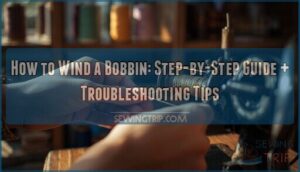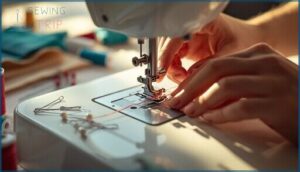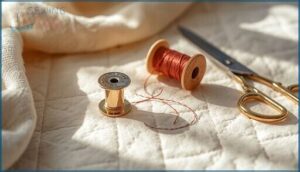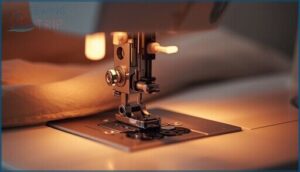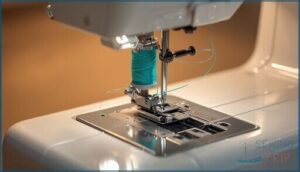This site is supported by our readers. We may earn a commission, at no cost to you, if you purchase through links.
You thread your machine, position your fabric, press the pedal—and nothing happens. Your top thread dangles uselessly because there’s no bobbin thread to lock with it. Every stitch your sewing machine makes depends on two threads meeting beneath the fabric, and when your bobbin runs empty mid-project, you can’t just keep going.
Learning how to wind a bobbin correctly prevents loose stitches, thread jams, and those frustrating moments when your sewing grinds to a halt. The winding process takes less than two minutes once you know the steps, but small mistakes in thread tension or bobbin placement create problems that can take twenty minutes to diagnose and fix.
Table Of Contents
Key Takeaways
- Wind your bobbin with steady, even tension in under two minutes to prevent loose stitches, thread jams, and mid-project interruptions that waste twenty minutes of troubleshooting time.
- Check your machine’s manual for the exact bobbin type (Class 15 or 66, plastic or metal) because using the wrong size throws off tension and causes jams you can’t fix with technique alone.
- Watch for three clear signals that your bobbin is full: the automatic stop clicks, you hear a higher-pitched sound, and the thread lies smooth across 80-90% of the rim without bulging past the edges.
- Thread your bobbin counterclockwise through the tension slot until it clicks, then test the spin—a wobbly bobbin or one that doesn’t rotate freely will ruin your stitch quality before you even start sewing.
What is a Bobbin and Why It Matters
A bobbin is a small spool that sits inside your sewing machine and holds the bottom thread. When you sew, this bottom thread loops with the top thread to create every stitch.
If your bobbin isn’t wound correctly, you’ll deal with tangles, skipped stitches, and frustrating stops that interrupt your project.
Bobbin Basics for Sewing Machines
A bobbin is a small spool that holds your sewing machine’s lower thread. Most household machines use plastic class 15 bobbins, while industrial models need specialized metal ones. You’ll find the bobbin inside the case below your needle, where it feeds thread upward.
Proper bobbin sizing and materials matter—mismatched bobbins throw off thread tension and cause frustrating jams during sewing.
How Bobbin Thread Forms Stitches
Your sewing machine creates each stitch when the needle thread loops around the bobbin thread below the fabric. The shuttle hook catches your needle thread and pulls it under, where it interlocks with the bobbin thread from the case.
This lockstitch pattern depends on balanced thread tension. If your bobbin feeds unevenly, you’ll see loose loops or puckered seams instead of smooth, professional stitches.
Importance of Proper Bobbin Winding
Getting thread tension right starts before you even thread your needle. When you wind your bobbin unevenly or too loosely, you’re setting yourself up for skipped stitches and tangled bird-nests under your fabric.
Proper bobbin winding creates uniform thread layers that feed smoothly through your machine, preventing those frustrating mid-project interruptions. Master this one simple technique, and you’ll transform your sewing efficiency while protecting your bobbin materials from unnecessary wear.
Master proper bobbin winding to create uniform thread layers that prevent frustrating interruptions and transform your sewing efficiency
Essential Supplies for Winding a Bobbin
You don’t need much to wind a bobbin, but having the right supplies makes the process smooth and frustration-free. Your sewing machine already has most of what you need built in.
Let’s walk through the essential items you’ll use every time you wind a bobbin.
Choosing The Right Bobbin Type
Your machine won’t work properly with the wrong bobbin—it’s that simple. Check your manual to find the correct class, like Class 15 or Class 66.
Bobbin material matters too: plastic or metal affects tension settings and thread compatibility. Using the manufacturer-recommended size ensures smooth bobbin winding and prevents jams.
Match the bobbin sizing to your machine for consistent bobbin thread performance and easier bobbin maintenance.
Selecting Thread and Spool Pin Setup
Choose polyester all-purpose thread in 40–50 weight for adaptable bobbin winding on most fabrics. Your spool pin setup matters: horizontal pins work best for cross-winding spools, while vertical pins suit stacked thread. Place the thread so it unwinds smoothly without twisting, which keeps bobbin tension even.
Match thread fiber to your project—polyester stretches slightly, cotton stays stable on your sewing machine’s bobbin winder. For best results, consider the thread choice factors when selecting your thread.
Locating and Using The Thread Guide
Look for a small metal pin or channel near your sewing machine’s bobbin winder—that’s your thread guide. Thread passes through this guide to maintain proper thread tension control and guide positioning during winding.
Position the thread so it flows straight from spool to guide to bobbin winder with no sharp bends. Clean alignment prevents uneven winding and keeps your thread management smooth throughout the winding mechanism.
Step-by-Step Bobbin Winding Process
Winding a bobbin takes just a few minutes once you know the right steps. You’ll prepare your machine, thread it correctly, and guide the bobbin as it fills with thread.
Follow these steps in order for smooth, even winding every time.
Preparing The Machine for Bobbin Winding
Before you start bobbin winding, plug in your sewing machine and flip the power switch on. Locate the bobbin winder spindle on the right or front of your machine.
Raise the presser foot to loosen thread tension for smooth winding. Check that your handwheel is stationary so the needle won’t move during the process.
Threading The Machine for Bobbin Winding
You’ll find the Thread Path Optimization diagram in your sewing machine manual—it shows exactly where your thread needs to travel. Pull thread from the spool pin through each designated guide point to establish proper Bobbin Tension Control.
Here’s your threading checklist:
- Place your spool on the Spool Pin Alignment post with thread feeding counterclockwise
- Guide thread through the Machine Threading Diagrams path toward the bobbin winder
- Follow Winding Direction Guidance to guarantee even bobbin thread distribution
Placing and Securing The Bobbin
After threading, you’ll position your empty bobbin onto the bobbin winder spindle—press it down until you hear a click. This Secure Placement guarantees proper Bobbin Alignment during winding.
Pull your bobbin thread through the small hole in the bobbin, leaving a 4-inch tail. Push the bobbin wind pin to the right to engage the winder, which prevents Bobbin Rotation issues and maintains Thread Tension throughout the Bobbin Case filling process.
Operating The Bobbin Winder and Foot Pedal
Once your bobbin winder engages, gently press the foot pedal to begin bobbin winding. The pedal’s pressure determines your sewing machine’s motor efficiency and winding speed—steady pressure yields smooth thread tension and consistent bobbin winder mechanics.
- Apply constant, moderate pedal pressure for even rotation
- Avoid abrupt starts that cause tangled thread
- Monitor the drive mechanism’s steady hum
- Release pressure if thread bunches or catches
Monitoring Even Thread Distribution
As your bobbin fills, watch the thread layers build across its surface. Even wrapping happens when thread distributes uniformly from edge to edge without gaps or lumps. Bobbin alignment and proper thread tension work together—you’ll see smooth, flat layers instead of peaked centers or loose edges.
Slow your winding speed if you notice thread bunching at one end—that signals your thread management needs adjustment.
| What to Watch | What It Means |
|---|---|
| Uniform color bands | Thread distribution is consistent |
| No visible gaps | Winding speed is ideal |
| Flat bobbin surface | Bobbin alignment is correct |
| Smooth layer transitions | Thread tension stays stable |
| Even edge-to-edge fill | Tension disk works properly |
Finishing and Inserting The Wound Bobbin
You’ve finished winding your bobbin, and now it’s time to wrap things up and get it into your machine. This part is quick, but you need to do it right so your thread feeds smoothly during sewing.
Here’s how to remove the bobbin, trim the excess thread, and place it correctly in the bobbin case.
Knowing When The Bobbin is Full
Watch for three clear signals during bobbin winding. Most machines stop automatically when thread reaches about 80 to 90 percent of the bobbin’s rim—that automatic stop prevents jamming.
Listen for a higher-pitched sound as the bobbin fills. Check visually: the thread should lie smooth and even across the surface, never bulging past the edges.
A properly filled bobbin shows consistent thread distribution from side to side.
Safely Removing and Trimming Thread
Once the automatic stop clicks, release your foot from the pedal. Cut the thread about two inches above the bobbin with sharp scissors—this thread removal prevents loose ends during sewing.
Lift the bobbin straight up from the winding spindle. Trim any stray tails flush with the wound surface.
Check the layers for consistent winding tension across the entire bobbin.
Opening The Bobbin Case
Turn off your machine before you begin. Locate the bobbin case beneath the needle plate—it may slide out or require a small latch release. Don’t force anything; consult your manual if the case doesn’t move easily.
Clear any lint from the bobbin winder shaft and drop-in bobbin case area with a soft brush. Proper bobbin case removal and lint prevention guarantee smooth thread tension and case alignment for consistent stitching.
Correctly Placing The Bobbin in The Case
Check the direction—your bobbin thread should unwind counterclockwise when you hold the case. Drop the bobbin into the case so it rotates freely, then pull the thread through the tension slot until it clicks.
Proper bobbin alignment and case tension guarantee smooth thread routing during stitch formation. Confirm the bobbin sits flat and spins without wobbling before closing the drop-in bobbin case.
Troubleshooting Common Bobbin Winding Issues
Even with careful setup, bobbin winding doesn’t always go smoothly. You might notice loose thread, uneven layers, or a bobbin that won’t catch at all.
Here’s how to fix the most common problems and get back to sewing.
Fixing Loose or Uneven Bobbin Winding
When your bobbin looks lopsided or thread bunches on one side, you’re dealing with tension or alignment issues that’ll wreck your stitch quality. Here’s how to fix it:
- Pull the thread taut as it feeds through the tension disk during bobbin winding
- Inspect your bobbin for burrs or damage that disrupts bobbin balance
- Adjust winding speed to maintain steady thread distribution
- Use the correct bobbin type to guarantee proper bobbin alignment
Dealing With Overfilled or Jammed Bobbins
Excess thread transforms your bobbin into a ticking time bomb. When you overfill, the outer layers slip and spring off, binding inside the bobbin winding shaft housing and creating bird-nesting under your fabric.
| Problem | Cause | Fix |
|---|---|---|
| Thread binding | Overfilled bobbin | Remove excess thread to safe fill level |
| Snagging edges | Too much thread packed | Inspect bobbin for burrs; reseat carefully |
| Uneven tension | Misaligned winder shaft | Check bobbin winder shaft alignment |
Stop winding when the thread reaches the bobbin’s rim—not beyond it.
Resolving Thread Not Catching Problems
When your bobbin thread refuses to lock with the upper thread, stitch formation stalls completely. This frustration stems from misaligned bobbin alignment, incorrect needle position, or improper thread tension at the tension disk.
- Verify the needle is fully inserted and correctly positioned in the clamp
- Check the bobbin winder shaft didn’t engage during sewing
- Re-thread both top thread and bobbin through proper paths
- Adjust fabric settings to match your material weight
Adjusting Bobbin Tension and Case Alignment
When your stitches look messy on one side, tension adjustment often solves the problem. Locate the small screw on your bobbin case and turn it clockwise in tiny quarter-turns to tighten. Test on scrap fabric after each adjustment. Case alignment matters too—seat the bobbin case fully into the housing with the notch aligned to prevent thread jams.
Document your final settings for sewing optimization and future reference.
| Adjustment Type | Solution |
|---|---|
| Loose bottom stitches | Tighten bobbin case screw clockwise |
| Puckered fabric | Loosen tension disk slightly |
| Uneven winding | Check bobbin winder shaft engagement |
| Thread nesting | Verify case alignment with housing marker |
| Inconsistent balance | Test on similar fabric weight before sewing |
Top 5 Bobbin and Thread Products for Sewing
You need the right supplies to wind bobbins correctly and sew with confidence. Quality bobbins and thread make a real difference in stitch quality and machine performance.
Here are five products that work well for beginners and experienced sewers alike.
1. StiVerse Sewing Thread Bobbins
When you’re searching for reliable bobbins that won’t break the bank, StiVerse offers impressive value. These Class 15 bobbins fit most household sewing machines from Brother, Singer, and Janome.
The clear plastic construction lets you monitor thread capacity at a glance, while smooth edges prevent snagging during bobbin winding. At roughly $0.10 to $0.30 per bobbin, they deliver solid winding performance across various sewing techniques.
The durable bobbin material withstands repeated use, and bobbin compatibility with multiple machines makes them a practical choice for your sewing toolkit.
- Clear plastic design lets you see thread color and amount without removing the bobbin, making organization simple
- Compatible with most household machines (Brother, Singer, Janome) at a fraction of the cost of brand-name bobbins
- Smooth construction prevents thread snagging and maintains consistent tension during sewing
- May not work with all machine models—some users report compatibility issues with specific machines like the Brother SE2000
- Thread quality and performance can vary depending on your particular sewing machine setup
- Bobbins aren’t individually sealed, so they might shift around or fall out during shipping
2. Sewing Thread Color Variety Pack
You’ll appreciate the HDST-HOME Color Variety Pack’s 36 sewing thread spools with matching prewound bobbins when organizing your sewing techniques. The 100% polyester material gives you consistent tension across color variety packs, while 360 yards per spool ensures long-lasting bobbin storage tips.
Each bobbin contains 40 yards of Class 15-compatible thread, perfect for your thread management needs. At under $0.50 per spool, you’re getting solid value.
Just confirm your sewing machine has automatic winding—these won’t work with Singer Futura machines.
- 36 colors with matching bobbins give you plenty of options for most sewing projects without buying individual spools
- At 360 yards per spool, you get decent thread length that’ll last through multiple projects before needing replacements
- The price point makes it easy to stock up on colors you might not use often but need occasionally
- Some spools arrive with damaged centers, which can cause wobbling or feeding issues during sewing
- Not compatible with all machines—specifically won’t work with Singer Futura embroidery models
- Quality control can be inconsistent, so you might need to check each spool before starting important projects
3. Brothread Embroidery Bobbin Threads
You need consistent thread quality for embroidery techniques, and Brothread’s Type L (SA155) prewound bobbins deliver exactly that. Each bobbin holds 4,330 inches of lint-free 60WT polyester—enough to complete multiple projects without constant bobbin winding.
The 25-color selection gives you color flexibility for matching or contrasting your designs. These work with Smartstitch, Ricoma, Happy, and Tajima machines, though you should verify bobbin compatibility before purchasing.
The plastic-sided bobbin materials include clear cases for easy organization, and the consistent draw-off tension prevents those frustrating thread breaks during high-speed embroidery on your sewing machine.
- Each bobbin holds 4,330 inches of thread, so you can finish several projects without stopping to reload
- The 25-color assortment gives you plenty of options for matching or contrasting with your top thread
- Lint-free polyester construction keeps your machine cleaner and reduces maintenance time
- Some users report thread breakage issues, especially at higher speeds
- The plastic bobbin cases can have rough edges that occasionally snag in certain machines
- Machine compatibility varies—these won’t fit every embroidery machine perfectly, so check your specs first
4. Eoehro Sewing Machine Bobbins
When you’re working with multiple projects, the Eoehro 50-pack plastic bobbins give you plenty of backups without breaking the bank. These standard-size bobbins measure 0.8 × 0.45 × 0.27 inches and fit most Singer and Brother models, though you’ll want to double-check your machine’s bobbin size first.
The transparent bobbin material lets you see thread levels at a glance, and the smooth, scratch-resistant surface prevents snagging during bobbin winding. Some users report slight size variations between bobbins, so inspect them before loading thread onto your sewing machine.
- 50-pack offers great value and ensures you always have spare bobbins on hand
- Transparent design makes it easy to check thread color and quantity at a glance
- Smooth, scratch-resistant surface helps prevent thread snags during winding
- Size variations between bobbins mean you should check each one before use
- Some users find them slightly smaller or flimsier than expected
- May not fit all machines despite being marketed as standard size
5. Janome Memory Craft Sewing Machine
If you’re investing in a full-featured sewing machine, the Janome Memory Craft 8200QCPSEWVIP manages bobbin winding alongside sophisticated stitching. This 27-pound computerized machine includes a built-in ACUFEED FLEX system and automatic needle threader, making bobbin compatibility and thread tension easier to manage through its LCD control panel.
The bobbin winding mechanism operates independently, so you can prep multiple bobbins without interrupting your project. The included straight stitch plate and variety of feet support precise bobbin maintenance across quilting and heavy-duty sewing tasks.
- Built-in ACUFEED FLEX system handles multiple fabric layers smoothly, perfect for quilts and heavy materials
- Independent bobbin winding lets you prep bobbins without stopping your sewing project
- 9mm stitch width and extensive stitch library (including alphabets) give you creative flexibility
- At 27 pounds, it’s pretty heavy and not easy to move around or transport
- Some users report reliability issues like error codes and the machine stopping unexpectedly
- Limited 2-year electronics warranty and customer support challenges have been noted
Frequently Asked Questions (FAQs)
What are the steps to winding a bobbin?
Ever wonder why your stitches look uneven? Place your thread spool on the pin, guide thread through tension discs, secure the empty bobbin on the winder, then press the pedal.
What is the correct way to thread a bobbin?
Pull thread from your bobbin clockwise, keeping it flat and tangle-free. Leave a few millimeters extending beyond the slot.
Check for even rotation, then seat it in the bobbin case following thread direction.
How do you wind a weaving bobbin by hand?
Wrap thread around the weaving bobbin’s center, building even layers from flange to flange. Keep steady tension as you wind clockwise.
Check for uniform distribution to prevent loose warps or thread snags during weaving.
Can you hand wind bobbins?
You can hand wind bobbins on most household machines using the manual bobbin winding spindle.
Proper bobbin tension remains essential for smooth thread management and preventing tangles during sewing. It’s a practical auxiliary supply option.
How do I fix a bobbin winding issue?
Start by re-threading your machine and checking for thread tension issues. Slow your winding speed, verify bobbin alignment in the winder, and confirm you’re using the correct bobbin type for consistent results.
What is the ideal bobbin thread tension?
Your bobbin tension should feel like a gentle handshake—not too tight, not too loose.
Test on scrap fabric first; balanced stitches show no looping on either side, with threads interlocking evenly between layers.
Can I use any type of thread?
Not every thread works well—cotton and polyester are your safest choices.
Thread compatibility with bobbin materials matters, and thick or specialty threads can disrupt tension control and cause uneven winding on most machines.
How often should I replace the bobbin?
Like a tire that wears with miles, your bobbin doesn’t need replacement on a schedule—only when you spot damage, warping, or nicks during routine sewing machine maintenance and bobbin wear inspections.
What are signs of a worn-out bobbin?
Check your bobbin for visible nicks, grooves, or rough edges that snag thread.
If thread frays during winding or stitches become uneven, those are classic bobbin wear signs indicating it’s time to replace it.
Can I reuse partially filled bobbins later?
Yes, you can reuse partially filled bobbins later. Clean them with a lint-free cloth before rewinding to prevent tension issues. Always wind in the same direction and check for cracks or warping first.
Conclusion
Right when you need your machine most—mid-seam on a gift deadline—you’ll discover whether you wound that bobbin correctly. Master how to wind a bobbin now, before tension problems cost you hours of unpicking stitches.
Check your thread’s even distribution, test your bobbin’s spin, and keep spares wound for your next project.
Your sewing machine runs on two threads working together. When both are ready, you create instead of troubleshoot.
- https://sewcanshe-sewingbee.mn.co/
- https://youtu.be/XQg2VPdUHQQ
- https://www.maggieframes.com/blogs/embroidery-blogs/polyester-vs-cotton-thread-how-to-choose-the-right-one-for-your-project
- https://www.qualitysewing.com/blogs/news/sewing-thread-guide-weights-uses
- https://www.mh-chine.com/blog/products/cross-wound-thread-vs-stacked-thread-unveiled

